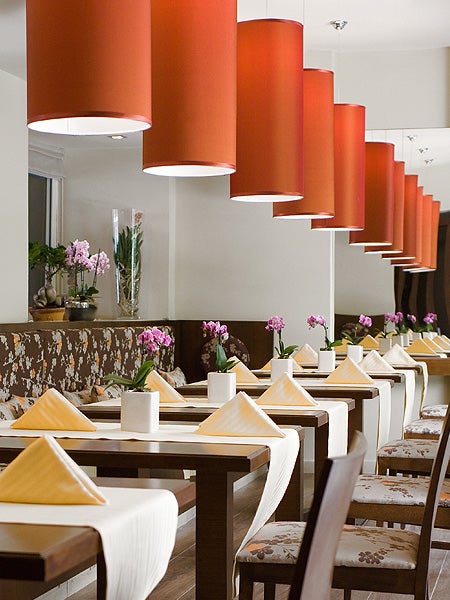Restaurant lighting is a dynamic part of a dining experience that can enhance or detract from it. In an age of social media, higher expectations of culinary experiences, and the desire for more aesthetically pleasing food, lighting plays a big role.
We break down some actionable restaurant lighting ideas for your restaurant, offering you the best methods to showcase your food and the work you put into each plate.
Key Takeaways:
- Restaurant lighting is used to set the tone of a restaurant and provide a functional pillar in your establishment.
- Lighting can be tweaked to alter the mood, perception, and overall impact the dining experience has on a guest.
- The more time you spend perfecting your lighting, the better the overall experience your customers and employees will have.
1. Understand Restaurant Lighting Basics
Lighting in restaurants sets the tone for guests to experience your product. If you have ever experienced a restaurant with poor lighting, you will understand just how vital it is to get this aspect of your business right. Furthermore, understanding lighting is key to keeping both workers and customers safe while also being a business that is compliant with safety laws.
Below are some key fundamentals to keep in mind when choosing the lighting for your restaurant:
- Atmosphere and aesthetics: Identify the ambiance and vibe you want diners to have in your restaurant. This will help you determine your lighting style.
- Functionality: We will discuss “task lighting” more below, but essentially, your restaurant lighting design should be intentional. Errant lighting can be distracting and take away from your space.
- Safety and regulatory compliance: Lighting can direct customers to steps and pathways in your dining room and to emergency exits. Additionally, there are regulations for lighting over food and food prep areas and to ensure worker safety.
- Energy consumption: Invest in quality lights that can be used without running up your electricity bill.
2. Create a Safety Lighting Plan
A safety lighting plan is typically required by local regulatory bodies. Restaurants are more at risk of fire and other emergencies due to the constant use of open flames and other cooking mediums. Emergency electrical systems for your emergency lighting are required, so it is important to understand what is connected to them. Let’s discuss some of the safety lighting you should consider within your restaurant.
Exit Signs
Exit signs should be installed near or above all exits (you must have more than one exit for customers). You will need additional signs pointing to exit signs, showing the customer and workers directions for the nearest exit in an emergency scenario. Furthermore, there should not be more than 100 ft of space between the exit and the nearest visible sign directing to where the exit is. Each sign must have a backup battery pack in the case of a power outage. Finally, any door that could be mistaken for an emergency exit must be labeled with a sign that says “No Exit”.
The Occupational Safety and Health Administration (OSHA) has exact standards a business must comply with for exit and emergency lighting.

Emergency Lighting
Emergency lighting is used to direct customers where to go in an emergency and to illuminate an area if power goes out. Depending on your local regulatory bodies, the time for how long these systems last may vary. However, the emergency lighting system you install must have a backup battery system and must illuminate key areas in case of a power outage. These systems should be checked and maintained regularly.
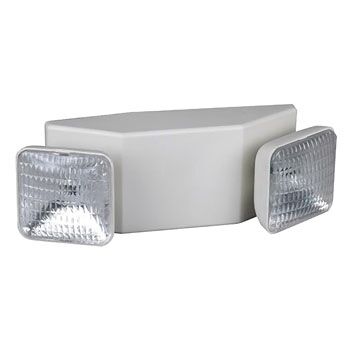
Smoke & Carbon Monoxide Alarms
Since smoke and carbon monoxide alarms are often looped into the same emergency electrical system as the other lighting above; they will often be a part of your emergency lighting plan. Both alarms are key to alerting of imminent danger, and regular checks and upkeep of these alarms are key.

Kitchen-grade Lightbulbs
A key factor in safety when lighting a kitchen is the strength of the lightbulb. Lightbulbs used in kitchens should not break easily and when hanging over food and prep areas, they must be shatter-resistant. Furthermore, these lightbulbs must have designated fixtures that prevent glass from entering food and other prep areas, according to the U.S. Food and Drug Administration (FDA).
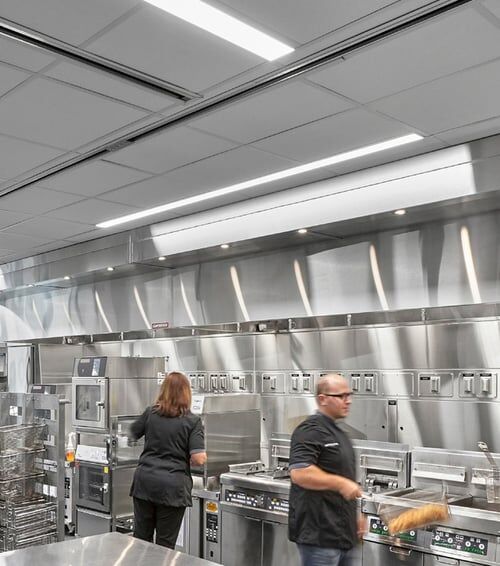
Safe and effective lighting is essential to a business, no matter the industry. Lighting in restaurants coincides with emergency lighting, and having a plan in place is key to ensuring the safety of both your employees and your customers. Be sure to understand all of your local regulations, and be on top of the necessary emergency lighting to keep your building in good standing.
3. Light Your Task Areas
Lighting your task areas requires much thought and a practical understanding of how your employees will do their jobs. In this section, we discuss the different areas to consider lighting in your restaurant and whether shatter-proof or other special lighting considerations should be made.
Cooking & Prep Areas
The cooking area should offer consistently bright lighting that does not put too much strain on the eyes, without gaps or darker areas of work. Kitchens should be well-lit, offering a full view of the workspace both for employee safety and efficiency. Bulbs should be shatter-proof, with covers to collect any glass or debris. Finally, lighting in these regions must be durable against grease, food splatter, steam, and water.
Lights in a kitchen must have an IP safety rating of 65 or 67 in order to be used. IP rating is a safety code that classifies the protection provided by electrical equipment enclosures against water, dust, and accidental contact.”]Additionally, a kitchen should be lit to 10 lumens or 1.07 lux per 100 square feet, per OSHA. Shatter-proof lighting plus installation can cost anywhere from $3,000 to $5,000. This depends on the amount of lighting needed in your space and additional installation costs.

Service Areas
Dining room areas can often be much dimmer than cooking areas, but you do need to keep in mind that waitstaff are also conducting their jobs in these spaces. Specific work areas for your employees must still be lit properly. You must meet OSHA regulations in key staff working areas, so making sure host stands, server stands, and other work areas are lit is vital for worker productivity. Furthermore, lighting key task areas in the dining room overall improves how a server serves their guests.

Be sure to note the different areas that do and do not require shatter-proof bulbs. For example, bars and deli counters are areas that process food. However, a host stand does not, leaving more options for lighting that is both aesthetically pleasing and functional. You need to keep in mind the tasks being done in different areas of your restaurant and where your lighting must be shatter-proof.
4. Create an Ambiance for Your Guests
Creating an ambiance for your guest is achievable through a multitude of lighting options. Below are some of the best restaurant lighting design ideas to ensure the proper tone and ambiance are set for your customers to enjoy.

Ambient Lighting
Ambient lighting is the general lighting you display for your guests. It can come from natural light pouring in from large windows. It is also set by the lighting system you have chosen to be your dining room’s main point of illumination. Ambient light is a powerful tool in a dining room, acting as the base for the rest of the lighting decisions you focus on.
Accent Lighting
Accent lighting adds a more refined depth of tone to a dining room. This light draws the eye to art pieces or refines the shape of a bar or the outline of a chef’s counter within a restaurant. Accent lighting pops visually and can tip the tone of a dining room in multiple ways if you use it correctly. Accent lighting is a key character builder to your dining room when paired with complementary ambient lighting.

Table Lighting
Table lighting is a wonderful piece of restaurant lighting that can add flare to the dining experience. Candles are the classic restaurant table lighting, but overhead hanging lamps, small table lamps, and lighting fixtures on walls can all offer a focused lighting feature to a table.
For fine dining restaurants I have worked in, there was always a notion that each table should feel encased in its own light, offering a “stage” for the food to be shown on. While you may have a different lighting philosophy, table lighting can make many dining experiences feel special.
Smart Lighting
Smart lighting systems can provide a variety of features to your restaurant. For starters, they can automatically dim lights based on customers’ capacity. They can also change based on timed settings. Many smart lighting systems have daylight sensors that track the time of day and adjust within. Finally, some smart light systems can change the light color, going into different hues based on your intended lighting design. These systems are more expensive but offer much more in-depth control of your lighting options.

Pendants, Chandeliers & Other Hanging Lights
Hanging light fixtures, such as chandeliers, have been symbols of luxury and elevated dining for decades. These sleek lights can often illuminate areas of your restaurants in a controlled way that sets the tone perfectly for your concept. There are a variety of options for these lights, so I suggest working with a professional on design and installation to find the best fit for your dining room.
Natural Lighting
Lastly, do not underestimate the value of natural lighting for a restaurant. Especially in warmer, sunnier climates, natural lighting can be a great anchor for your restaurant’s lighting options. Natural light in midday evokes a lively buzz, while light spilling in from a sunset gives your restaurant a uniquely warm feeling not achievable by electric lights. Natural light is a stunning visual tool when used correctly, so if you have the option, make the most of the natural light pouring into your dining room.
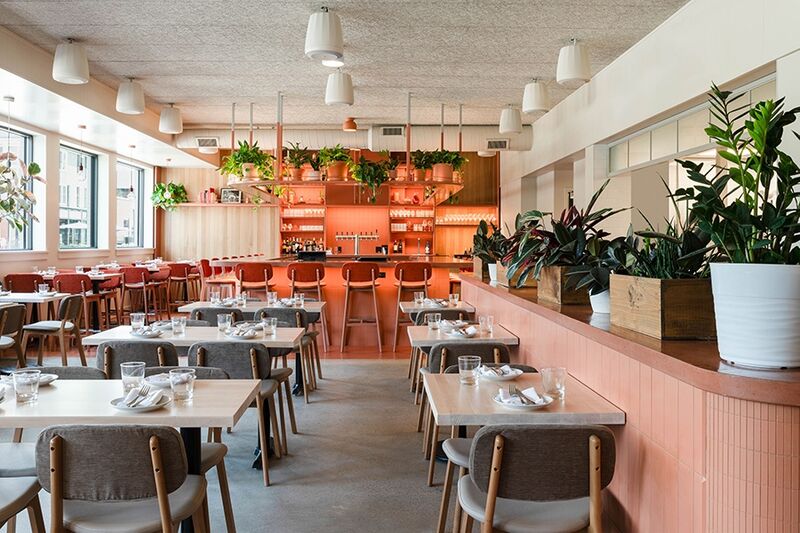
5. Invest in Outdoor Lighting
While a major emphasis is placed on indoor lighting for restaurants, outdoor lighting is just as important for a restaurant. Outdoor lighting sets the tone of a restaurant, offers functional guidance by illuminating a path to the restaurant, and is key in showcasing and marketing your restaurant to the outside world. The outdoor lighting for a restaurant can be the patio lights on an outdoor dining area, the lights that illuminate the sign of your business, or the lights that lead a path to your front door. Below are some lighting ideas for the outside of your restaurant.
Pathway Lighting
One key function of lighting an outdoor area of a restaurant at night is ensuring your guests can make it to the front door. Outdoor lights that illuminate a pathway are functional and offer different tones depending on how you utilize them. This is the perfect example of how lighting can set a guest’s first impression while also aiding them in their dining experience. With that being said, be mindful of the lights you choose to have guests first interact with. Warm lighting invites guests in, while harsh lighting can lead them to feel uninvited and distant from your business.
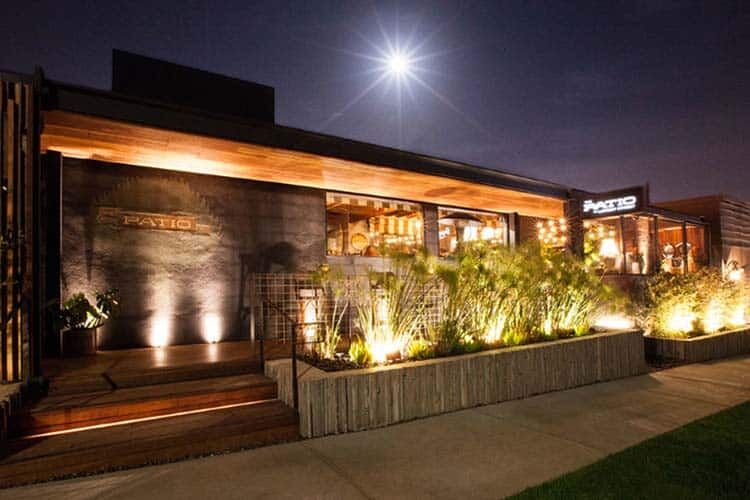
Patio Lights
Another important area to illuminate outside of your restaurant is your patio or outdoor dining area. Patios have a charming quality, so larger hanging bulbs, tall lamps, and other rustic-style lights really pop on patios. Patio lights should offer a warm environment while providing enough light for customers and servers to see food and drink. Outdoor dining areas are very popular, especially during warmer weather, and lighting them correctly creates a huge appeal for diners passing by your restaurant.

Exterior & Sign Lighting
The last major outdoor lighting section you should be aware of is the lighting that illuminates the outside of your building and signs. Some examples may be ground-based flood lights that shine onto the sign located on the side of your building. Or, the lighting on your business could be an illuminated neon sign, offering a sharp color tone with your brand’s name glowing through the darkness. However you showcase your restaurant and sign, be sure it is memorable and distinct enough to attract diners driving or walking by.

6. Learn About Light Temperature
In talking with different restaurant operators, there is a general consensus that 3000K to 3500K (Kelvin) is the ideal middle ground for dining room lighting. Lighting temperature is measured in Kelvin, and the higher the amount, the “cooler” the lighting being measured is. If you think about it on a scale, “warmer” light will be emitted from a lower temperature. To get an in-depth understanding of how lighting temperature is broken down, I found this highly informative LinkedIn article to be worth a read.

When we discuss a light temperature, many times, restaurants will stray towards warmer lights. Warmer lighting can evoke feelings of joy, coziness, restfulness, and an invitation into the space. Warm light can also be effective when showcasing food, as warmer colors cause more contrast in food and can enhance appetites. Furthermore, warmer temperatures can lead to longer stays, which could lead to more overall business. A warm, cozy environment will lend customers to being more comfortable, which in turn opens them up to ordering more food and enjoying the experience longer as long as it is a pleasant one.
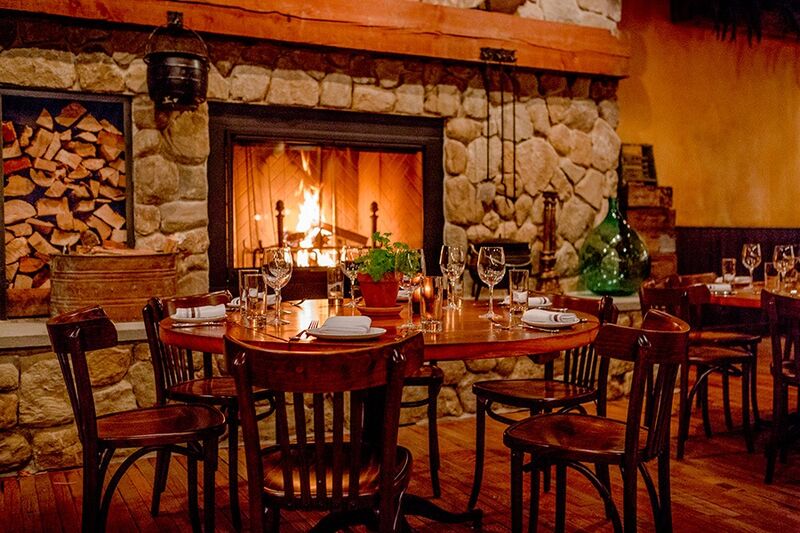
In contrast, a colder dining area offers greater visual depth to fresh foods such as vegetables and fruits. Cooler lighting can give a more modern aesthetic and often leads to shorter customer visits. However, cooler lighting can highlight a fresher space, such as a modern coffee shop or lunch-dominant sushi bar. Cool lighting is very effective when used right, as long as you understand the goals behind it.
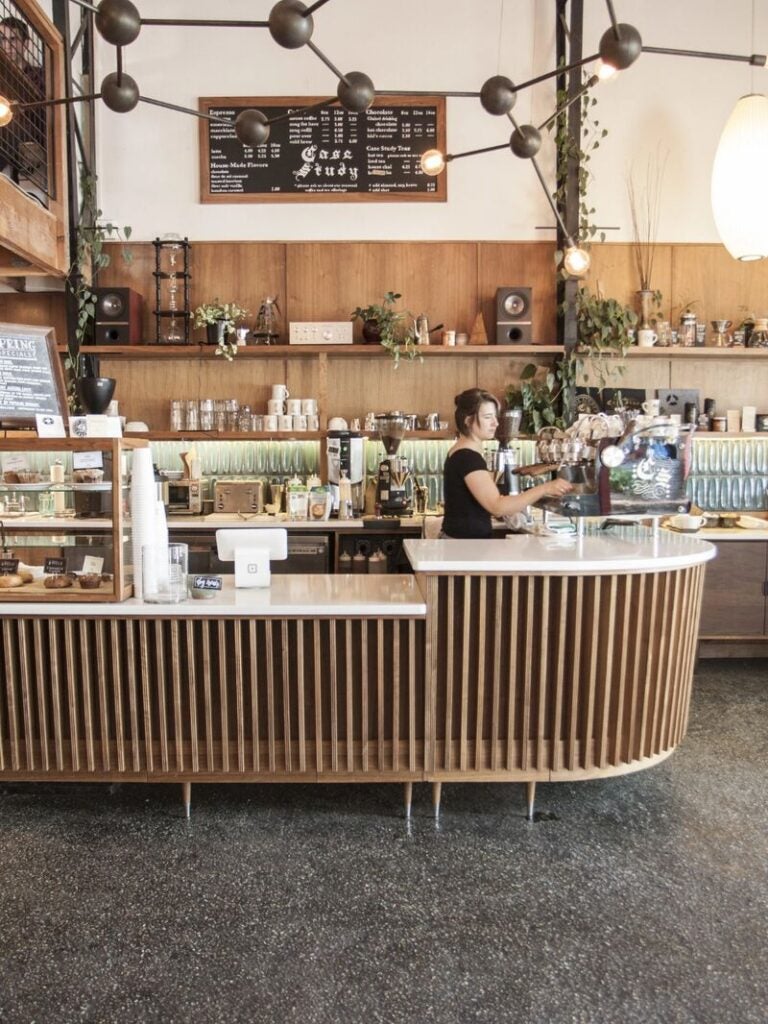
Of course, not all of your lighting needs to be one tone. You can have warmer lighting above tables and at the bar while offering cooler lighting at the entrance or in an open kitchen dining space. Blending lighting tones can also create unique visuals, so play around with the lighting temperature your business offers. The temperature of the colors you choose can greatly enhance your concept.
7. Remember Sustainability
Sustainability is something consumers demand to pay more attention to now than ever. Restaurant lighting can use up and draw a lot of energy, so choosing sustainable options not only betters the environment but also saves you money. Here is a quick list of restaurant lighting that should be considered in regards to energy-saving options:
- Occupancy sensors
- Motion sensors for outdoor lights
- LED lamps and dining room lighting
- LED lamps under hoods and other prep areas
- Lighting timers for restrooms, storage closets, walk-ins, dining rooms and office spaces
- Solar lighting for flood lights, parking lights, and pathway lighting
- Daylight sensors for both front of house (FOH) and back of house (BOH)
As you can see, there are systems and light designs that can save electricity and money for a restaurant. Also, many different eco-friendly lighting companies regard elegance of design as much as efficiency of power generation. Choosing sustainable sources does not need to be a choice between ambiance, design, and functionality. There are simply so many options now for better choices that positively impact the environment and your bottom line.

8. Hire Professionals When Needed
Due to the importance of restaurant lighting, there will be certain cases when hiring professionals is a good idea. This includes highly technical installations, installations of emergency electrical systems, hard-to-reach lighting fixtures, and any project you are not 100% confident performing yourself. While it may be cheaper to try to install lighting yourself, some projects are better left to the pros.
Installing a light-based sign on your restaurant, for example, is something a professional should be doing. Lining the underside of your bar with illuminating lights is another example of a highly technical installation process that professionals are better off doing. Lighting is a permanent fixture that has a ton of impact on both the aesthetic and functionality of your business. Cutting corners on lighting is never a good idea.
The cost of lighting installation can cost anywhere from $2 to $8 per square footage of your space, depending on the extent of the work involved. Additionally, you will need to pay for the cost of the light itself, which can vary based on the type, design, and overall craftsmanship of the light.
It is often easy to find a local commercial lighting company near you, and a quick Google search should suffice. Professional companies can often give you quotes, guidance, and an idea of how the project will go before beginning, so be sure to ask the right questions for the best result.
Frequently Asked Questions (FAQs)
Restaurant lighting can be a tough task for those without prior experience in restaurant design. That being said, there are some key questions often asked regarding how to light a restaurant. Here are some of the most common.
Last Bite
Restaurant lighting is a key feature of every food business. Every operator needs to be well-versed in its ability to set tone, help with safety, and garner emotion. Use the tips above to gain a fundamental understanding of restaurant lighting and to use lighting to give your valued customers the best total product. The restaurant lighting ideas above, paired with your restaurant concept, will deliver the types of experiences high-level food businesses are expected to offer.



